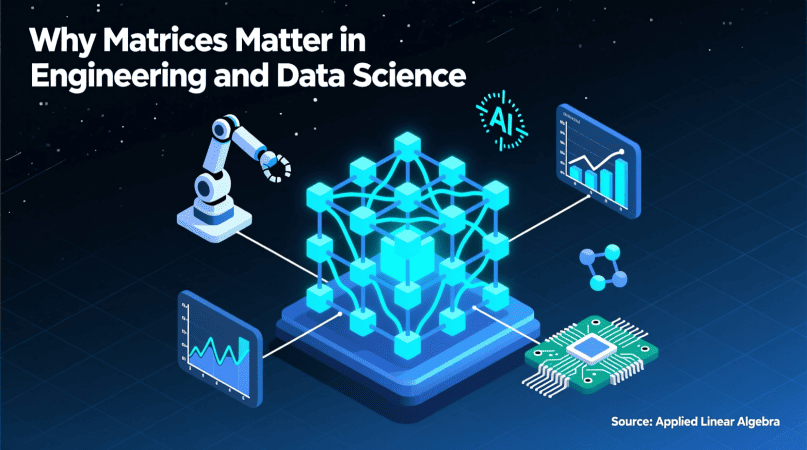
Matrices may look like grids of numbers, but they’re the language of modern computation.
From engineering design and physics simulations to machine learning and AI models — matrices are everywhere.
In this article, you’ll see why matrices matter, how engineers and data scientists use them every day, and how inverse and pseudo-inverse calculations make the modern digital world work.
What Is a Matrix? (Quick Recap)
A matrix is a structured arrangement of numbers in rows and columns.
It’s a compact way to represent systems, transformations, and relationships.
A=[ 1 4 2 5 3 6 ]
This simple object can describe:
- a system of equations,
- a 3D rotation,
- a dataset,
- or even the parameters of an AI model.
If you’re new to matrices, start with our What Is a Matrix guide to understand the basics.
Why Engineers and Data Scientists Use Matrices
Matrices simplify complex relationships into a single object that computers can process efficiently.
They form the backbone of every mathematical model that involves simultaneous variables, transformations, or large datasets.
Here’s why they’re indispensable:
- They represent systems of linear equations compactly.
- They simplify vector transformations in 2D and 3D space.
- They enable optimization, regression, and prediction in data science.
- They’re the mathematical foundation of deep learning and neural networks.
Matrices in Engineering
Engineering problems often involve multiple simultaneous relationships — structural stresses, circuit flows, or control systems.
Matrices let engineers express these problems mathematically and computationally.
1. Solving Systems of Equations
In mechanical or electrical systems, engineers often solve equations of the form: [ A X = B ]
where:
- (A) represents system parameters,
- (X) represents unknowns,
- (B) represents known outputs.
Finding X = A⁻¹ B requires computing the inverse of a matrix — a process easily handled by our Inverse Matrix Calculator.
You can also solve these interactively with the System of Equations Calculator.
2. Control Systems
In control engineering, matrices describe state-space models, such as: x˙=Ax+Bu,y=Cx+Du
Here, (A, B, C, D) are matrices representing dynamics, control inputs, and outputs.
Engineers use matrix inversion and multiplication to determine feedback and system stability — fundamental to robotics, automation, and aerospace design.
3. Electrical and Civil Engineering
In circuit analysis, matrices simplify Kirchhoff’s laws and nodal voltage equations.
In civil engineering, they model forces, loads, and displacements in structures.
Matrix methods make it possible to simulate entire bridges or electrical grids with hundreds of nodes.
4. 3D Graphics and Transformations
Every 3D model, from CAD designs to animations, uses matrix transformations.
Rotations, translations, and scaling operations are performed using transformation matrices.
A simple rotation matrix: R =[ cos(θ)sin(θ) − sin(θ)cos(θ) ]
To reverse transformations or correct distortion, engineers use the matrix inverse.
See our Matrix Inverse vs Transpose article for a deeper look at geometric implications.
Matrices in Data Science
Data scientists rely on matrices because every dataset, model, and algorithm can be expressed in matrix form.
1. Data Representation
A dataset with (m) samples and (n) features is stored as an (m \times n) matrix: X=[x11 x12 … x1n; x21 x22 … x2n; …; xm1 xm2 … xmn]
This representation allows computers to perform parallel operations efficiently, forming the basis of vectorized computation in Python, MATLAB, and R.
You can learn about computational methods in How to Calculate Inverse of a Matrix in Python.
2. Linear Regression and Prediction Models
In machine learning, the normal equation for linear regression is: θ = (XᵀX)⁻¹ Xᵀ y
This equation uses matrix transpose and inverse operations to compute model parameters.
If (Xᵀ X) is not invertible, the pseudoinverse is used instead: θ = X⁺ y
You can explore how these two differ in Matrix Inverse vs Pseudoinverse.
3. Neural Networks and Deep Learning
Every layer in a neural network performs a matrix multiplication: Z = W X + b
where (W) (weights) and (b) (biases) are matrices and vectors.
These operations happen billions of times during training.
The entire backpropagation process — how neural networks learn — is powered by matrix derivatives and transpose operations.
4. Dimensionality Reduction & PCA
Principal Component Analysis (PCA) uses eigenvalues and eigenvectors, both derived from matrices.
By decomposing a covariance matrix, PCA identifies directions of maximum variance — crucial for feature selection and noise reduction.
This concept connects directly to your Determinant of a Matrix guide, since determinants and eigenvalues are deeply linked.
The Role of Matrix Inversion
Matrix inversion allows us to reverse transformations and solve equations in both engineering and data science.
- In engineering: used to find system responses.
- In data science: used to compute regression weights.
However, not every matrix has an inverse.
If your data or equations are dependent or degenerate, you’ll encounter a singular matrix.
👉 Learn more in Why My Matrix Has No Inverse.
When a true inverse doesn’t exist, use a pseudoinverse — a generalization that works for rectangular or singular matrices:
Pseudo Inverse Calculator
How Computers Handle Matrices
Modern systems use linear algebra libraries like NumPy, MATLAB, or TensorFlow to perform millions of matrix operations per second.
These frameworks handle:
- Inversion
- Transposition
- Decomposition (LU, QR, SVD)
All these rely on mathematical fundamentals like the Gauss–Jordan method — explained step-by-step in our Gauss–Jordan Guide.
Summary: Why Matrices Are So Powerful
| Field | Application | Role of Matrices |
|---|---|---|
| Mechanical Engineering | Structural analysis | Stress, strain, and load modeling |
| Electrical Engineering | Circuit analysis | Solving voltage/current systems |
| Control Systems | Automation and feedback | State-space modeling |
| Computer Graphics | 3D modeling and rotation | Transformation and inverse |
| Data Science | Regression and prediction | Matrix inversion and pseudoinverse |
| Machine Learning | Neural networks | Weight updates via matrix math |
Matrices let you describe, compute, and reverse complex systems — something no scalar number system could handle efficiently.
Frequently Asked Questions
1. Why are matrices important in engineering?
They help engineers represent multiple equations, forces, and relationships simultaneously and solve them efficiently.
2. Why do data scientists use matrices?
Matrices handle large datasets and model parameters in algorithms like regression and neural networks.
3. What’s the difference between inverse and pseudoinverse?
The inverse exists only for square, non-singular matrices, while the pseudoinverse works for any shape or rank.
4. What if my matrix has no inverse?
It’s singular — use the pseudoinverse or adjust your dataset.
See Why My Matrix Has No Inverse.
5. Which calculators can I use for these problems?
Try our Inverse Matrix Calculator or Pseudo Inverse Calculator for quick solutions.
John H. Cleveland is the creator of Inversematrixcalculator.com, a trusted resource dedicated to providing accurate and easy-to-use matrix calculation tools. With a strong background in mathematics and a passion for simplifying complex concepts, John focuses on delivering clear, reliable solutions for students, educators, and professionals. His goal is to help users save time and confidently solve matrix problems with precision.
